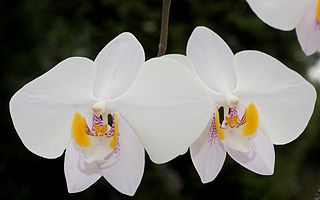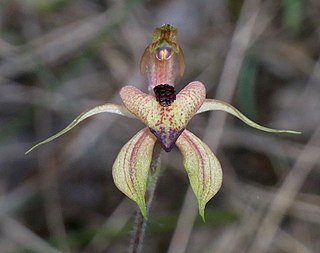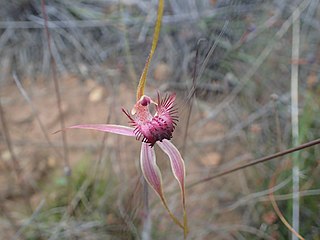
Restrepia, abbreviated Rstp in horticultural trade, is a small genus of 49 orchids in the orchid family (Orchidaceae), closely related to Pleurothallis. Named in honor of Don Jose Restrepo, it tends to be more showy than most other Pleurothallids. They are found primarily at higher altitudes in the cool, damp montane forests of the Andes and Venezuela, with some into Central America up to southern Mexico.

Restrepia antennifera, the Antennae-carrying Restrepia, is an epiphytic, miniature species of orchid found at higher altitudes in cool, moist montane forests in Venezuela, Colombia and Ecuador.
Restrepia chocoensis is a species in the orchid family (Orchidaceae), named for the Department of Chocó, Colombia, where it was discovered.
Restrepia citrina is an orchid, close related to the pleurothallinids.

Restrepia falkenbergii, commonly called the Falkenberg's Restrepia, is an epiphytic orchid, found at altitudes between 1,000-2,000 m in Colombia.

Caladenia flava, commonly known as cowslip orchid, is a species of orchid endemic to the south-west of Western Australia. It is a relatively common orchid with a single, hairy leaf and up to three yellow flowers which often have red markings. In 2001 three subspecies were named and a fourth is recognised but not as yet formally described.

Phalaenopsis philippinensis is an endemic species of orchid found from Luzon island in the Philippines.
Caladenia anthracina, commonly known as the black-tipped spider orchid, is a plant in the orchid family Orchidaceae and is endemic to Tasmania. It is a ground orchid with a single hairy leaf and a single white or cream-coloured flower with red markings and black tips on the sepals and petals.
Caladenia atradenia, commonly known as bronze fingers is a plant in the orchid family Orchidaceae and is endemic to New Zealand. It is a ground orchid with a thin, hairy leaf and a thin wiry stem bearing one or two dark green or greenish red flowers with maroon or magenta markings.
Caladenia brumalis, commonly known as winter spider orchid, is a plant in the orchid family Orchidaceae and is endemic to South Australia. It has an erect, hairy leaf and usually a single white to pinkish flower with darker markings. It is only found in a few places due to habitat loss and is considered to be vulnerable.

Caladenia cardiochila, commonly known as thick-lipped spider-orchid, fleshy-lipped caladenia and heartlip spider-orchid, is a plant in the orchid family Orchidaceae and is endemic to Victoria and South Australia. It is a ground orchid with a single hairy leaf and one or two yellowish-green, red-striped flowers on a thin, wiry stem.

Caladenia clarkiae, commonly known as pink caps, is a plant in the orchid family Orchidaceae and is endemic to south-eastern Australia. It is a ground orchid which grows singly or in small groups in Victoria and New South Wales. It has a single leaf and usually one or two white to pale pink flowers with darker pink tips.
Caladenia coactilis, commonly known as thick fingers, is a plant in the orchid family Orchidaceae and is endemic to South Australia. It is a ground orchid which grows singly or in loose groups and has a single hairy leaf and one or two flowers which are bright pink inside and brownish on the back.

Caladenia cucullata, commonly known as the hooded caladenia, is a plant in the orchid family Orchidaceae and is endemic to south-eastern Australia. It is a ground orchid with a single, sparsely hairy leaf, and up to seven white flowers with a purplish labellum.

Caladenia decora, commonly known as the Esperance king spider orchid is a species of orchid endemic to the south-west of Western Australia. It has a single hairy leaf and up to three red, yellow and green flowers. It is a variable species, similar to the king spider orchid and sometimes hybridises with other species so that it can be difficult to recognise, but is one of the largest spider orchids found in Western Australia.

Caladenia denticulata subsp. denticulata, commonly known as the yellow spider orchid, is a plant in the orchid family Orchidaceae and is endemic to the south-west of Western Australia. It has a single erect, hairy leaf and one or two yellowish flowers which have a white labellum with pale red markings.
Caladenia dienema, commonly known as the windswept spider-orchid, is a plant in the orchid family Orchidaceae and is endemic to Tasmania. It is a ground orchid with a single, hairy leaf and a single, variably-coloured, usually dark red flower on a thin, wiry stem 5–12 cm (2–5 in) high.
Caladenia denticulata subsp. rubella, commonly known as the clumped spider orchid, is a plant in the orchid family Orchidaceae and is endemic to the south-west of Western Australia. It has a single erect, hairy leaf and one or two dull or pinkish red flowers with prominent dull red markings and with a white labellum with red markings.

Caladenia dimorpha, commonly known as spicy caps, is a plant in the orchid family Orchidaceae and is endemic to New South Wales. It is an uncommon ground orchid with a single sparsely hairy leaf, and up to three white flowers which often have pinkish markings.

Caladenia rosea, also known as pink primrose orchid, is a plant in the orchid family Orchidaceae and is endemic to relatively inaccessible, high lateritic plateaux in a high rainfall area in south-western Western Australia. It is a terrestrial orchid with a single hairy leaf and up to three pink flowers on a thin, sparsely-hairy stem. It is similar to Caladenia flava but is distinguished by the perianth being pink to dark pink with prominent red striping and spotting on the dorsal sepal and lateral petals. Caladenia rosea mimics Hypocalymma robustum (Myrtaceae) in terms of flowering time, colour and scent.











